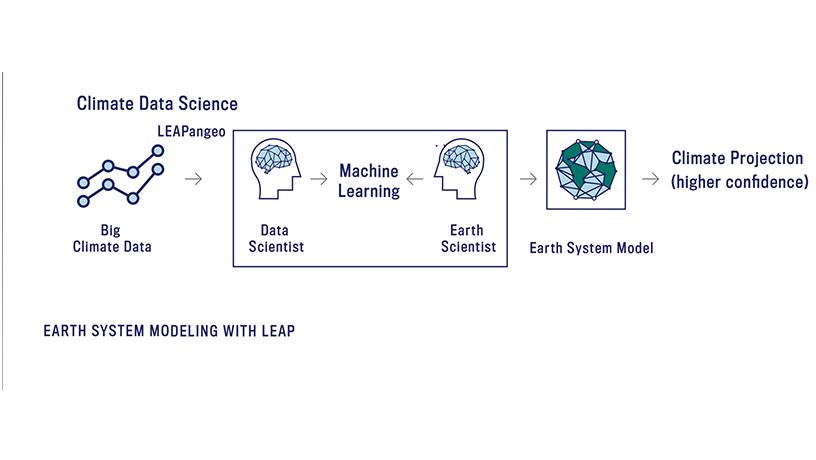Climate Intelligence
Combining physics and AI to better model the effects of climate change

There are 50,000 water utilities in the United States. Except for the very largest, these agencies generally cannot afford to undertake the sophisticated climate modeling that could help them hedge against future droughts or floods—a situation that leaves millions of Americans increasingly vulnerable to extreme weather.
Upmanu Lall, director of the Columbia Water Center, wants to change that by harnessing the power of machine learning. With global warming already increasing the intensity and frequency of extreme weather events, the need to make the nation’s water supply resilient by investing in, say, deeper wells or new dams has taken on new urgency. Using climate data, Lall’s tool would create a county-by-county data-base for the entire nation, giving climate forecasts for 3 months, 1 year, 5 years, and 10 years.
“If you are in New York City, then you can hire consultants to do this kind of analysis, but if you are a small county, you don’t have the budget for that,” says Lall, who is also a professor of earth and environmental engineering. “The point of using machine learning is to provide information that gives water managers a way to plan.”


Upmanu Lall, Alan and Carol Silberstein Professor of Earth and Environmental Engineering and professor of civil engineering and engineering mechanics.

Example of global precipitation forecast for January as percentile of the historical distribution, conditional on the “hidden state” of the tropical Pacific Sea Surface Temperature three months earlier, using a non-homogeneous hidden Markov model.
Lall, who leads a multi-university team including professors Casey Brown from University of Massachusetts Amherst, Scott Steinschneider from Cornell University, and Kenneth Kunkel from North Carolina State University, recently received a $1 million grant for his research from the National Science Foundation.
Together, his team is building and integrating machine learning models for climate and hydrologic forecasts and water systems simulations. Each of these objectives requires its own distinct machine learning tool. The researchers are integrating a wealth of crucial data, including water demand, infrastructure systems optimization, investment analytics, and financial risk transfer models.
But among the biggest hurdles in advancing climate forecasts are limitations in the models themselves, an area where artificial intelligence can help provide key improvements. Pierre Gentine, professor of earth and environmental engineering, also focuses on water—specifically, the relationship between water, carbon cycles, and climate change. Gentine works to fill crucial knowledge gaps in our understanding of the complex interplay between the land surface and the atmosphere. In January, his most recent research on soil moisture and atmospheric feed-backs in drylands was published in Nature Climate Change.
Gentine—who often collaborates with Assistant Professor Carl Vondrick and Associate Professor Elias Bareinboim (both of computer science)—is pioneering new methodologies at the interface between artificial intelligence and physical knowledge so that global climate models can benefit from a more refined, and more realistic, use of machine learning. “We have been doing that with evaporation—looking at evaporation from forests and grasslands and crops,” he points out. “When you have knowledge of the evaporation process and combine this with your AI algorithm, that works so much better than using a brute-force machine learning approach, especially when looking at extreme events such as droughts or heat waves.”
Early climate models were crude, he says, not only in their resolution (now much finer) but also in their presentation of physical and biogeochemical forces. But as the questions around climate change get more urgent, they also get more complicated. “For example, people want to study the carbon cycle or the atmospheric chemistry,” he says. “That’s adding a lot of complexity to the models. It’s not just about predicting temperature or precipitation. It’s also how much CO2 will be picked up in the future by forests—like, say, in the Amazon.”

Pierre Gentine, Maurice Ewing and J. Lamar Worzel Professor of Geophysics and professor of earth and environmental sciences.

Schematic illustrating approach of the proposed LEAP project, a collaboration between Gentine and Columbia colleagues Galen McKinley, Tian Zheng, and a number of other faculty.
Answering those questions in an ever-shifting landscape requires creativity. “Often,” Gentine cautions, “you might not be able to make sure that everything you put into the model is correct because you don’t have the observations” to cross-check them. To address that, he uses data from regions where researchers have documented a particular phenomenon—for example, desertification—and applies it to regions where those trends are emerging, which enables better understanding of the coming impacts.
Lall, too, is relying on buckets of data for his water supply models. Among the many inputs are global sea surface temperatures dating to 1900, drought estimates across North America going back 500 years, and statistics on wind and humidity related to the jet stream, rainfall records, and predictions from climate models.
Many climate models that look at sea-level rise or temperature peer into the far future, when the most severe impacts of climate change are expected. But for water utilities, Lall says, understanding the decade ahead is equally as important.
“We are focusing on the short and long term deliberately because most people are focusing on 2050 to 2100,” he explains. “You are not going to build a dam based on something happening 50 years out. Making these kinds of forecasts for three months or five years will give utilities the most risk mitigation. You want to time the amount of water in a dam to minimize the risk.”
